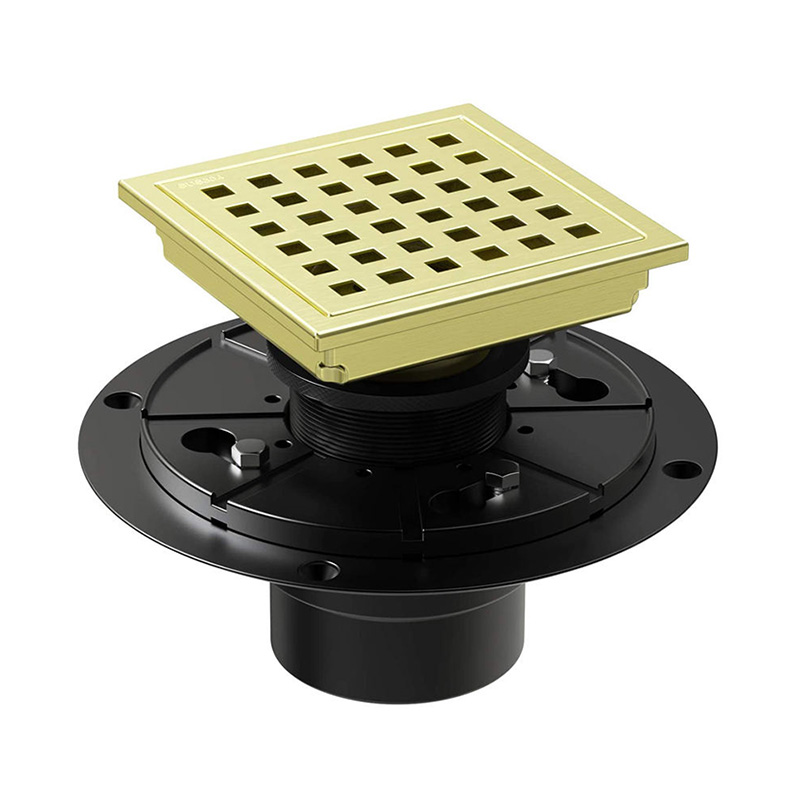Why Is My Shower Draining Slow
A slow-draining shower is one of the most common—and frustrating—bathroom problems. You step into a relaxing shower, but by the time you finish, water has pooled around your feet instead of draining smoothly. This isn’t just inconvenient; it often indicates that your Shower Drain system is partially clogged or improperly designed.
If your shower water takes too long to disappear, it’s essential to understand why it happens, what causes the issue, and how to prevent it. Our stainless steel shower drains are engineered to eliminate such problems with features like high-flow channels, removable strainers, and anti-blocking structures. In this article, we’ll explain the causes of slow drainage, how to fix them, and why upgrading to a well-designed shower drain can keep your bathroom efficient and hygienic.
1. Understanding Why Shower Drains Slow Down
1.1 Hair and Soap Scum Buildup
The number one reason for slow drainage is the accumulation of hair, soap residue, and body oils in the drainpipe. Every time you shower, small amounts of hair and shampoo mix to create sticky clumps that cling to the pipe’s inner walls. Over time, these clumps harden and restrict water flow.
| Cause | Description | Impact |
|---|---|---|
| Hair accumulation | Strands wrap around the strainer or inside the trap | Slows down water flow |
| Soap scum | Soap reacts with minerals in hard water | Forms waxy layers inside pipes |
| Body oils | Combine with hair and dirt | Create sticky blockages |
Our Shower Drain Series features fine removable baskets that catch hair before it reaches the pipes, ensuring consistent and fast water drainage.
1.2 Improper Drain Design or Installation
Drainage problems are not always caused by clogs—sometimes, the problem lies in poor drain design or incorrect installation. A slow slope, small outlet diameter, or improper sealing can all prevent water from flowing efficiently.
Low Slope Gradient: The floor should have a slight slope toward the drain (1–2%), guiding water naturally. If it’s too flat, water will pool.
Small Outlet Size: Drains with undersized outlets can’t handle large water flow rates, especially with high-pressure showers.
Incorrect Connection: Misaligned pipes or loose joints can create flow resistance and partial blockages.
Our stainless steel shower drains are precision-engineered with optimal slope geometry and high-capacity outlets, allowing water to discharge rapidly without backflow or pooling.
1.3 Blocked P-Trap or S-Trap
The P-trap (or S-trap) is the curved section of the drainpipe located beneath the shower floor. Its purpose is to hold a small amount of water that blocks sewer gases from entering the bathroom. However, it’s also a common spot for blockages.
| Problem | Description | Result |
|---|---|---|
| Partial Blockage | Hair and debris stuck in the bend | Water drains slowly or backs up |
| Complete Blockage | Trap fully filled with gunk | Water doesn’t drain at all |
| Evaporation | Water dries out if shower isn’t used often | Allows air pressure imbalance and slow flow |
Modern drains from our collection use a modular trap system with an easily detachable water seal, allowing quick cleaning and preventing recurring buildup.
1.4 Hard Water Deposits
If you live in an area with hard water, minerals like calcium and magnesium can accumulate along the drainpipe. These deposits gradually reduce the pipe’s diameter, restricting water flow and causing persistent drainage problems.
Visual Clues: White, chalky residue around the drain cover or outlet.
Long-Term Effects: Narrower drainage paths and potential corrosion in metal pipes.
Our SUS304 stainless steel drains resist scale adhesion, making them far easier to maintain in hard water environments.
2. How to Diagnose a Slow-Draining Shower
Identifying where the blockage occurs helps determine whether a simple cleaning or a professional fix is needed.
2.1 Visual Inspection
Remove the drain cover using a screwdriver or lifting hook.
Check for visible hair, dirt, or soap buildup around the edges.
If the water level drops faster after cleaning the surface, the blockage is near the top.
2.2 Water Test
Pour one liter of hot water into the drain and observe:
Fast flow: No major obstruction.
Slow flow: Partial blockage deeper inside.
No movement: Severe clog in the trap or pipe.
| Observation | Likely Problem | Solution |
|---|---|---|
| Water stagnates immediately | Clogged trap | Remove and clean P-trap |
| Water drains slowly | Soap or hair buildup | Use baking soda + vinegar |
| Gurgling sound | Air pressure imbalance | Check trap seal and vent |
| Odor present | Organic matter decomposing | Deep clean or replace drain core |
2.3 Smell and Sound Indicators
A foul smell or bubbling noise during drainage often means that waste particles are decomposing inside. Stainless steel drains with anti-odor silicone seals prevent such smells by isolating the sewer air from your bathroom.
3. Solutions to Fix and Prevent Slow Drainage
3.1 Clean the Drain Regularly
Routine cleaning keeps your drain flowing freely. You can clean it effectively using basic household materials.
Step-by-step cleaning method:
Remove the drain cover and pull out the strainer basket.
Dispose of trapped hair and rinse the basket with hot water.
Pour ½ cup of baking soda into the drain, followed by 1 cup of vinegar.
Wait 15–20 minutes for the foaming reaction to dissolve buildup.
Flush with boiling water to clear the pipe.
| Tool | Use | Effectiveness |
|---|---|---|
| Soft brush | Scrubs residue without scratching metal | High |
| Baking soda + vinegar | Natural degreaser | Medium-high |
| Drain snake | Removes deeper clogs | High |
| Hot water rinse | Melts soap scum | Medium |
Our shower drains simplify this process—just lift the grate, remove the hair basket, rinse, and reinstall. No need for harsh chemicals or deep dismantling.
3.2 Upgrade to a High-Flow Drain System
Older or low-cost drains may not handle large volumes of water effectively, leading to slow drainage even when clean. Upgrading to a professional-grade shower drain can eliminate these limitations.
Features of our stainless steel high-flow drains:
Deep water channels designed to increase discharge speed.
Removable baskets for easy cleaning and hair capture.
Anti-blocking geometry that prevents debris accumulation.
Odor and insect-resistant valves to maintain hygiene.
| Feature | Function | Advantage |
|---|---|---|
| Sloped inner base | Directs water quickly to outlet | No water pooling |
| Large outlet diameter | Handles higher flow rate | Faster drainage |
| Precision welding | Prevents leakage | Long-lasting seal |
| Polished steel surface | Resists residue buildup | Easy to clean |
These engineering details ensure water drains immediately after each use, even in high-traffic bathrooms.
3.3 Maintain the Trap and Sealing System
The trap and seal are crucial for both odor control and flow efficiency. If your shower isn’t used frequently, the trap water may evaporate, causing both smell and slow flow.
Maintenance Tips:
Pour a cup of water weekly to refill the trap.
Remove and rinse the trap insert monthly.
Check the silicone seal for cracks or deformation.
Replace damaged components to restore full suction.
Our shower drains feature integrated water seals that automatically close when not in use, blocking odor and ensuring steady water flow without manual refilling.
3.4 Avoid Common Mistakes
Many homeowners unintentionally worsen their drain performance. Here’s what to avoid:
Pouring oil or leftover soap into the drain—it solidifies over time.
Ignoring minor slowdowns, which often become full clogs.
Using harsh chemical cleaners, which can damage silicone and metal parts.
Skipping regular cleaning, allowing biofilm to form.
A simple monthly cleaning routine prevents expensive plumbing repairs later.
4. Why Upgrading Your Shower Drain Solves the Problem Permanently
4.1 The Role of Material Quality
Traditional plastic drains deform under heat, warp over time, and are prone to bacterial buildup. In contrast, SUS304 stainless steel drains offer superior durability and performance:
Corrosion-resistant: Withstands moisture and cleaning chemicals.
Smooth surface finish: Reduces hair adhesion and soap residue.
Aesthetic appeal: Matches modern tile or stone bathroom designs.
This makes stainless steel an ideal long-term solution for efficient drainage.
4.2 Advanced Structure for Continuous Flow
Our drains are built with a multi-layer construction to maximize efficiency and prevent slow draining.
| Layer | Function | Material |
|---|---|---|
| Top Grate Cover | Filters debris and hair | Brushed stainless steel |
| Filter Basket | Captures hair before it enters pipe | Fine-perforated steel |
| Drain Body | Guides water flow | Precision-welded SUS304 |
| Anti-Odor Water Seal | Blocks gases and insects | Silicone sealing core |
| Outlet Connector | Connects to drainage pipe | PVC / Steel hybrid |
This design ensures smooth, uninterrupted flow and keeps your bathroom both clean and odor-free.
4.3 Enhanced Flow Rate Testing
Our shower drains are tested for high-flow performance under simulated real-world conditions:
Flow capacity up to 60 liters per minute.
Tested against hair, soap, and mineral residue accumulation.
Certified for both residential and commercial bathroom applications.
This ensures that your shower floor stays dry and that water clears quickly, even during extended use.
4.4 Easy Maintenance and Hygiene
The combination of a removable basket, anti-odor seal, and flush-fit design allows users to clean the drain within seconds. The seamless surface prevents dirt buildup, while the detachable components make maintenance effortless without requiring plumbing tools.
Conclusion
A slow-draining shower is usually caused by hair buildup, soap residue, or poor drain design—but it doesn’t have to be a recurring problem. By maintaining a regular cleaning routine and upgrading to a high-performance stainless steel shower drain, you can eliminate slow water flow for good.
Our modern shower drain systems feature precision-engineered water channels, removable strainers, and odor-blocking seals that guarantee fast drainage and a hygienic environment. With proper care, they not only prevent clogs but also enhance the overall look and comfort of your bathroom.
Don’t settle for standing water—invest in a stainless steel shower drain that keeps your shower efficient, odor-free, and built to last.




